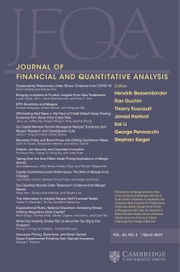No CrossRef data available.
Article contents
The New Keynesian Model and Bond Yields
Published online by Cambridge University Press: 14 March 2025
Abstract
This article presents a New Keynesian model to capture the linkages between macro fundamentals and the nominal yield curve. The model explains bond yields with a low level of news in expected inflation and plausible term premia. This implies that the slope of the yield curve predicts future bond yields and that risk-adjusted historical bond yields satisfy the expectations hypothesis. The model also explains the spanning puzzle, matches key moments for real bond yields, captures the evolution of the price-dividend ratio, and implies that the slope of the yield curve and the price-dividend ratio forecast excess equity returns.
Information
- Type
- Research Article
- Information
- Journal of Financial and Quantitative Analysis , Volume 60 , Issue 7 , November 2025 , pp. 3551 - 3590
- Copyright
- © The Author(s), 2025. Published by Cambridge University Press on behalf of the Michael G. Foster School of Business, University of Washington
Footnotes
I thank Robert Goldstein (the referee), Kasper Jørgensen, Anders Bredahl Kock, Dennis Kristensen, Giovanni Pellegrino, Morten Ravn, and Daniel Wilhelm for useful comments and discussions. I also appreciate comments from participants at the Cemmap seminar at the University College London.

